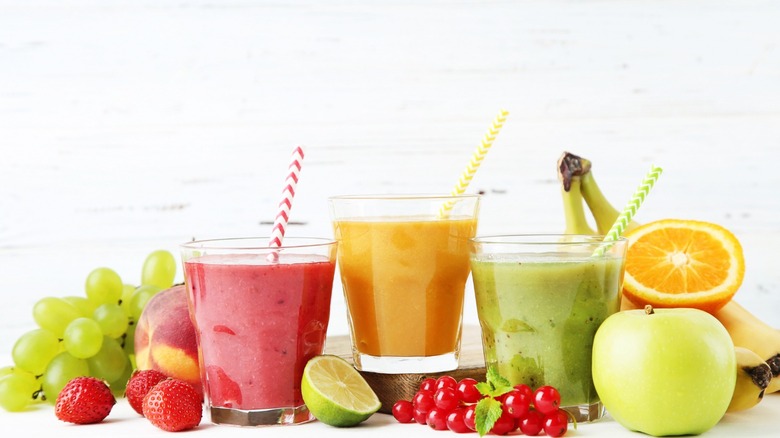You Should Reconsider Drinking Fruit Smoothies For Breakfast. Here's Why
Most fruit smoothies taste deliciously like dessert. After all, that's part of the appeal, right? Get your daily dose (or at least some) of fruits and veggies packed into a delicious, portable, and nutritional wallop that goes down easy. Whether you're blending strawberries and bananas, pairing orange with mango, or mixing a berry blend with protein powder, the simple process of making a nutritious smoothie recipe can be immensely satisfying. Press that blender button and watch it all whirl together: Fresh fruit, greek yogurt, nut butter, and a little coconut milk — it's the kind of thing you want to see first thing in the morning. But wait — before you dive into smoothie bliss, you should make sure your morning smoothie is helping you start your day off on the right track.
When it comes to fruit smoothies, there are a few key tips that can make all the difference in determining whether your blend is nutritionally beautiful or busted.
Watch the sugar content
Filled with vitamins, minerals, and fiber that studies have shown can promote gut health, fruits are a nutritional win, but many smoothie recipes contain more than just fruits and veggies. Some include sweeteners like honey, maple syrup, and other sugars tucked into protein powders; even certain types of milk, yogurt, juice, and nut butter could adversely impact blood sugar levels.
Commercially prepared fruit smoothies may not carry the same nutritional benefits as the ones you make at home. As The New York Times observes, some smoothies that you purchase at a store don't even use whole fresh fruit offering the examples of Starbucks' strawberry smoothie (which is made with strawberry purée and white grape juice concentrate, among other ingredients and Smoothie King's Hulk Strawberry (which contains ice cream).
Though eating your fruits and veggies whole is the best option for those concerned with getting the most nutritionally out of the meal, making a smoothing at home is a smarter choice than buying one on the go. On Nutritionfacts.org, Dr. Michael Gleger advises a careful selection of the fruits tossed into the blender; bananas, mango, and berries perform best in glycemic studies. Adding extra ingredients? Read labels to identify hidden sugars and maximize ingredient choices, as Healthline points out even natural sugars can spike blood sugar.
Common digestive complaints
If your tummy is a bit fussy post-morning smoothie, you could be dealing with digestive issues caused by malabsorption, food intolerance, or food allergies. In addition to fruit sugars called fructose (which some people are unable to digest effectively), Healthline advises there are several common smoothie ingredients that are frequently found on food intolerance and allergy lists; Nuts, soy, and dairy are all predictable intestinal aggravators.
The Cleveland Clinic identifies two main types of fructose intolerance, dietary and hereditary. Those with dietary fructose intolerances have malabsorption, which means intestinal cells do not absorb fructose, thus leading to a host of digestive symptoms. Though some symptoms of dietary and hereditary fructose intolerance overlap, those with the hereditary form are dealing with a more serious condition that can lead to extreme cases like organ failure, coma, and even death. Luckily for some, new research indicates help for those with certain food allergies may be on the way.
Set up for smoothie success
With careful planning and some label reading, it is possible to make tasty smoothies a nutritious part of your daily routine. Not only can you reduce and eliminate any excess sugars hidden in your smoothie recipes, but you can also boost the fiber content of your delicious creation with spoonfuls of chia or flax seeds, nuts, berries, and bran cereals (via SF Gate).
Maintain consistent blood sugar levels and boost your morning energy levels with controlled smoothie portions. Choose fruits with denser nutrition profiles; mangoes, bananas, berries, acai, and dragon fruit are excellent choices. (This mango banana smoothie recipe blends several of these ingredients together or consider a dragon fruit bowl for tomorrow's breakfast.) Most smoothie recipes can be enhanced with oat milk, yogurt, or coconut water, and no smoothie recipe is set in stone, so feel free to pick whatever blend works best with your dietary and nutritional needs in mind.



